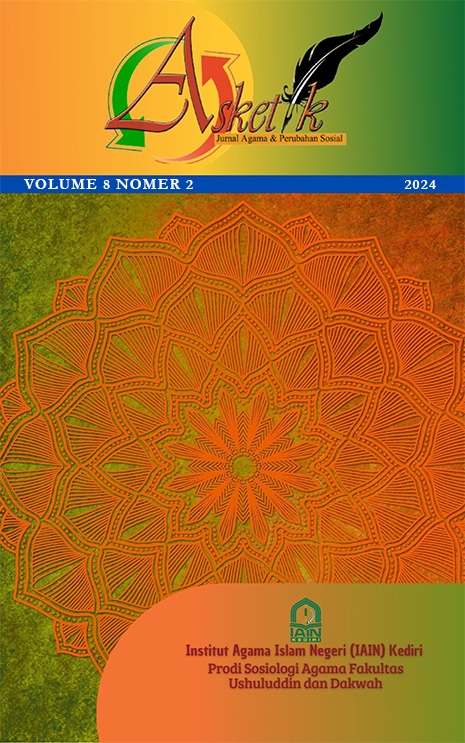Map of Tourism Village Management in Kudus Regency, Central Java
DOI:
https://doi.org/10.30762/asketik.v8i2.2157Keywords:
Tourism Villages, Management Disparity, CapitalAbstract
This research examine the pioneering process of tourist villages in Kudus, by looking at management and capital that influence tourism development. This research used qualitative approach, with purposive sampling to determine research object and informants by looking at the criteria for 3 sub-districts that have the highest number of tourist villages. Researchers interviewed pioneer actors and tourism village managers and the surrounding community, supported by observational data. The results of this research show that there were differences and disparity in the development of tourist villages in North Kudus and South Kudus. It can be seen from the history of the establishment of tourism and management. The tourist village in North Kudus appears sporadically because there are quite a lot of private parties. This influences the management strategy which is investor-based with the support of financial capital and the sensitivity of actors (investors) in capturing natural potential and visiting opportunities (production center development). It was different from the Tourism Village in South Kudus which historically emerged because of collective awareness (social capital) to develop social activism and economic opportunities through tourism villages. Therefore managing natural and cultural potential carried out collectively by empowering local communities (people center development).
Downloads
References
Amrullah, Umi Kaltum, Merry Citra Sondari, and Diaz Pranita. 2023. “The Influence of Capability, Business Innovation, and Competitive Advantage on a Smart Sustainable Tourism Village and Its Impact on the Management Performance of Tourism Villages on Java Island.” Sustainability 15(19):14149. doi: 10.3390/su151914149.
Anon. n.d.-a. “15 Desa Di Kudus Jadi Desa Wisata.” Retrieved October 30, 2021 (https://jatengprov.go.id/beritadaerah/15-desa-di-kudus-jadi-desa-wisata/).
Anon. n.d.-b. “Badan Pusat Statistik.” Retrieved November 16, 2022 (https://kuduskab.bps.go.id/statictable/2015/01/26/5/luas-wilayah-kabupaten-kudus-menurut-kecamatan.html).
Anon. n.d.-c. “Buka Luwur Kangjeng Sunan Kudus Bagian Dari Nguri-Uri Budaya | PPID Kudus.” Retrieved December 21, 2022 (https://ppid.kuduskab.go.id/post/312/buka-luwur-kangjeng-sunan-kudus-bagian-dari-nguri-uri-budaya).
Anon. n.d.-d. “Tahun Ini Kabupaten Kudus Punya 13 Desa Wisata Baru | MURIANEWS.” Retrieved October 30, 2021 (https://www.murianews.com/2021/05/19/218507/tahun-ini-kabupaten-kudus-punya-13-desa-wisata-baru).
Anon. n.d.-e. “Warisan Budaya Takbenda | Beranda.” Retrieved December 21, 2022 (https://warisanbudaya.kemdikbud.go.id/?newdetail&detailCatat=4712).
Atk. 2022. “Sejarah Dan Pengelolaan Pijar Park.”
BPS, BPS. 2015. “Kudus Dalam Angka Tahun 2015.”
Faisal, Sanapiah. 2010. Format-Format Penelitian Sosial. Jakarta: Raja Grafindo Persada.
Gianna, Moscardo (ed). 2008. Building Community Capacity For Tourism Development. United Kingdom: CAB International.
Gnd. 2022. “Pengelolaan Desa Wisata Wonosoco.”
Idrus, Muhammad. 2009. Metode Penelitian Ilmu Sosial. Jakarta: Erlangga.
Ihsan, M. 2018. “GUSJIGANG; KARAKTER KEMANDIRIAN MASYARAKAT KUDUS MENGHADAPI INDUSTRIALISASI.” IQTISHADIA 10(2):153–83.
Istriyani, Ratna. 2021. “Consuming Leisure Time: How The Tourism Trend Has Changed the Village | Journal of Contemporary Sociological Issues.” Retrieved October 30, 2021 (https://jurnal.unej.ac.id/index.php/JCSI/article/view/19803).
Johnson, Doyle Paul. 1991. Teori Sosiologi Klasik Dan Modern (Terj. Robert M. Z. Lawang). Jakarta: Gramedia Pustaka Utama.
Kemenparekraf. n.d. “Desa Wisata Terus Tumbuh Sebagai Pariwisata Alternatif.” Kemenparekraf. Retrieved October 30, 2021 (https://www.kemenparekraf.id).
Koentjaraningrat, Koentjaraningrat. 1984. Masyarakat Desa Di Indonesia. Jakarta: Fakultas Ekonomi Universitas Indonesia.
Media, Kompas Cyber. 2022. “Peranan Kerajaan Demak dalam Menyebarkan Islam di Pulau Jawa Halaman all.” KOMPAS.com. Retrieved December 20, 2022 (https://www.kompas.com/stori/read/2022/09/15/190000879/peranan-kerajaan-demak-dalam-menyebarkan-islam-di-pulau-jawa).
Nasdian, Fredian Tonny. 2015. Pengembangan Masyarakat. Jakarta: Yayasan Pustaka Obor Indonesia.
Neuman, W. Lawrence. 2013. Metodologi Penelitian Sosial: Pendekatan Kualitatif Dan Kuantitatif. Jakarta: Indeks.
Rahardjo. 2017. Pengantar Sosiologi Perdesaan Dan Pertanian. Yogyakarta: Gadjah Mada University Press.
Rahmawati, Ulfah. 2019. “Motif Sosio-Theogenetis Dalam Tradisi Manakiban Masyarakat Mejobo Kudus.” FIKRAH 7(1):115–32. doi: 10.21043/fikrah.v7i1.4842.
Rmytn. 2022. “Pengelolaan Taman Wisata Colo (Rahtawood).”
Rosalina, Putu Devi, Karine Dupre, Ying Wang, I. Nyoman Darma Putra, and Xin Jin. 2023. “Rural Tourism Resource Management Strategies: A Case Study of Two Tourism Villages in Bali.” Tourism Management Perspectives 49:101194. doi: 10.1016/j.tmp.2023.101194.
Sihotang, Doni Sugianto, and Achmad Hidir. 2022. “Strategi Pengelolaan Ekowisata Berbasis Joint Tourism Pada Objek Wisata Sungai Gagak di Desa Koto Mesjid, Kabupaten Kampar, Riau.” Indonesian Journal of Tourism and Leisure 3(1):1–15. doi: 10.36256/ijtl.v3i1.171.
Ysf. 2022. “Sejarah Dan Pengelolaan Pijar Park.”
Zubaedi. 2007. Wacana Pembangunan Alternatif: Ragam Perspektif Pengembangan Dan Pemberdayaan Masyarakat. Yogyakarta: Ar-Ruzz Media.
Downloads
Published
How to Cite
Issue
Section
License
Copyright (c) 2024 Ratna Istriyani

This work is licensed under a Creative Commons Attribution-ShareAlike 4.0 International License.





















